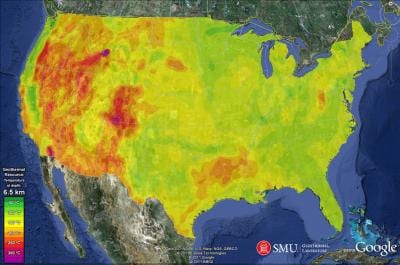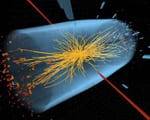Energy Department Announces Finalists for National University Geothermal Energy Competition
A group of SMU graduate students has been selected as one of three finalist teams in a prestigious national geothermal energy competition sponsored by the U.S. Department of Energy. The DOE Office of Energy Efficiency and Renewable Energy competition challenges student teams to conduct research aimed at breakthroughs in geothermal energy development.
The SMU Geothermal Laboratory student team members — Zach Frone, Joe Batir, Ryan Dingwall and Mitchell Williams — are presenting their project at the 36th Geothermal Resources Council Annual Meeting in Reno, Nev., Sept. 30-Oct. 3. The other two student teams presenting their work in this last stage of the competition are from Idaho State University and Boise State University.
SMU’s Geothermal Laboratory is a renowned national resource for the development of clean, green energy from the Earth’s heat. Sophisticated mapping of geothermal resources produced by David Blackwell, SMU’s Hamilton professor of Geothermal Studies, and Maria Richards, director of SMU’s Geothermal Laboratory, makes it clear that vast geothermal resources reachable through current technology could replace and multiply the levels of energy currently produced in the United States by mostly coal-fired power plants.
MIT study identified Snake River as potential area for geothermal development
The student teams involved in the DOE competition have been analyzing the economic feasibility of developing geothermal energy in Snake River Plain, Idaho.
In announcing the competition, the Department of Energy noted that a 2006 study conducted by the Massachusetts Institute of Technology (Blackwell and Richards were part of the study team) identified Snake River Valley as one of six potential areas in the United States for near-term geothermal development.
The region has geothermal resources with temperatures higher than 200°C at a depth of less than three miles, which is considered optimal for energy development.
Dingwall explained that the SMU team developed and ran fluid flow models for the competition, using temperatures measured in wells in the West Snake River Plain, published geologic information and other data.
The results indicate the area is viable for direct use geothermal applications (naturally occurring hot water drawn from below the earth’s surface) or enhanced geothermal systems, which require artificially circulating liquid through rock formations to heat it to temperatures high enough to produce energy.
U.S. install geothermal capacity exceeds that of rest of world
The United States currently has 3,177 megawatts of installed geothermal energy capacity, according to the Geothermal Energy Association, which far outpaces production in the rest of the world.
California and Nevada are the U.S. production leaders. However, Blackwell and Richards’ research through the SMU Geothermal Lab, available at Google.org’s EGS Home Page, has confirmed and refined locations across North America with resources capable of supporting large-scale commercial geothermal energy production under a wide range of geologic conditions. — Kimberly Cobb
Follow SMU Research on Twitter, @smuresearch.
For more SMU research see www.smuresearch.com.
SMU is a nationally ranked private university in Dallas founded 100 years ago. Today, SMU enrolls nearly 11,000 students who benefit from the academic opportunities and international reach of seven degree-granting schools. For more information, www.smu.edu.
SMU has an uplink facility located on campus for live TV, radio, or online interviews. To speak with an SMU expert or book an SMU guest in the studio, call SMU News & Communications at 214-768-7650.


 To book a live or taped interview with David Blackwell in the SMU
To book a live or taped interview with David Blackwell in the SMU 
 Human diabetes has new research tool: Overfed fruit flies that develop insulin resistance
Human diabetes has new research tool: Overfed fruit flies that develop insulin resistance
 Ancient tree-ring records from southwest U.S. suggest today’s megafires are truly unusual
Ancient tree-ring records from southwest U.S. suggest today’s megafires are truly unusual